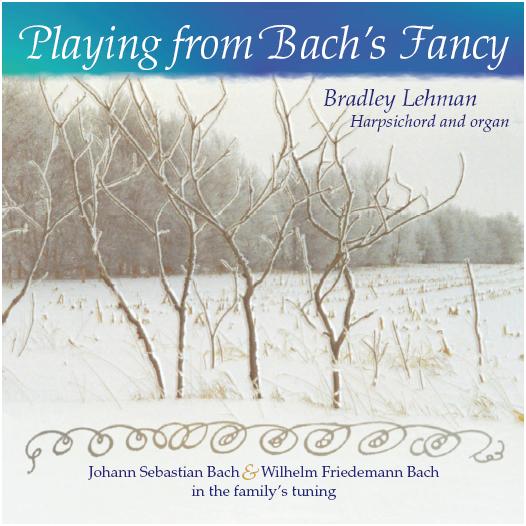 LaripS.com, © Bradley Lehman, 2005-22, all rights reserved. All musical/historical analysis here on the LaripS.com web site is the personal opinion of the author, as a researcher of historical temperaments and a performer of Bach's music. The Tuning...for Peter Watchorn's CD series of the Bach harpsichord works, on MusicaOmnia. This introductory essay appears in the booklets of the Well-Tempered Clavier (book 1) and the Inventions & Sinfonias. © Bradley Lehman, November 2005 The tuningIn J. S. Bach's obituary it was reported: "In the tuning of harpsichords, he achieved so correct and pure a temperament that all the tonalities sounded pure and agreeable. He knew of no tonalities that, because of impure intonation, one must avoid." I believe that Bach's elegant diagram at the top of his Well-Tempered Clavier title page defines that "correct and pure" temperament. It establishes a specific set of sounds for every musical scale and for all harmonies. Every major scale and minor scale sounds different from every other. This allows music to project a subtly different mood or character in each melodic and harmonic context, with a pleasing range of expression as it goes along. It builds drama into the music. A tuner of harpsichords or organs, making the intervals very slightly compromised on purpose (as Bach's drawing indicates), ends up with a keyboard tuned beautifully for music in all keys. This carefully balanced result was apparently Bach's preferred system, and it solves all the practical problems in his music and the music of his sons. Indeed, it turns out to be an excellent tuning solution to play all music, both before and after Bach's. My article presenting this hypothesis is "Bach's extraordinary temperament: our Rosetta Stone," published in the February and May 2005 issues of Early Music (Oxford University Press). Further details about this temperament are in the November 2005 issue of Clavichord International, and at www.larips.com. The layout is: F-C-G-D-A-E 1/6 comma narrow 5ths; The result sounds almost like equal temperament in its smoothness, and it similarly allows all keys to be used without problem, but it has much more personality and color. In scales and triads it sounds plain and gentle around C major (most like regular 1/6 comma temperament), mellower and warmer in the flat keys such as A-flat and E-flat major (most like equal temperament), and especially bright and exciting in the sharp keys around E major (like Pythagorean tuning, with pure 5ths). Everything is smoothly blended from these three competing systems, emerging with an emphasis on melodic suavity. The following chart uses a measurement scheme from Neidhardt's Sectio canonis, 1724, and developed further and more accurately in later publications by Sorge. The three stacked major 3rds within each (pure) octave are measured for their relative size, within a total of 21 units for each set of three: each row of this chart. The intervals having higher numbers sound spicier, more restless, with a more vigorous vibrato.
In this measurement, a value of 11 would indicate a major 3rd that is one syntonic comma too sharp (a "Pythagorean major third," having been generated by four pure 5ths). A pure major 3rd would be represented here as 0. Equal temperament, as opposed to the variety shown here, has a constant size of 7 in all twelve of the major 3rds. Regular 1/6 comma temperament, for further contrast, has in each row two 3s and a 15, where the 15s indicate the "wolf" diminished 4ths such as G#-C or F#-Bb. In functional harmony, the Bach tuning sets up especially interesting contrasts within minor-key music. In the minor keys from one flat to three sharps, the dominant triad (V) is much stronger/brighter than the tonic, creating forward motion for relaxed resolution. In the minor keys with two or more flats, that relationship is reversed, with a dominant that is calmer than the tonic: making a gentle effect overall, yet leading into intense or troubling conclusions. In major-key music, the triads on degrees I, IV, and V have characters similar to one another. The sizes of major 3rds change by only 1, 2, or 3 units from each key to its neighbors, moving by the circle of 5ths (through typical subdominant/tonic/dominant progressions). Any change of Affekt is therefore gradual and subtle, as if we never really leave the home key altogether but it feels a little more or less tense as we go along. To summarize those two important observations: major-key passages tend to give a luxurious and unproblematic flow, a basically even-keeled personality. Minor-key passages tend to draw more attention to themselves with powerfully dramatic strokes, more vivid and obvious gestures. Bach's first biographer, Forkel, wrote: "Nobody could install the quill-plectrums of his harpsichord to his satisfaction; he always did it himself. He also tuned both his harpsichord and clavichord himself, and was so practiced in the operation that it never cost him above a quarter of an hour. But then, when he played from his fancy, all the 24 keys were in his power; he did with them what he pleased. He connected the most remote as easily and as naturally together as the nearest; the hearer believed he had only modulated within the compass of a single key. He knew nothing of harshness in modulation; even his transitions in the chromatic style were as soft and flowing as if he had wholly confined himself to the diatonic scale. (...)" "In the modulation of his instrumental works, every advance is a new thought, a constantly progressive life and motion within the circle of the keys chosen and those nearest related to them. Of the harmony which he already has he retains the greatest part; but at every advance he mixes something related to it; and, in this manner, he proceeds to the end of a piece so softly, so gently and gradually, that no leap or harsh transition is to be felt; and yet no bar (I might even say, no part of a bar) is like another. With him, every transition was required to have a connection with the preceding idea and to appear to be a necessary consequence of it. He knew not, or rather he disdained, those sudden sallies by which many composers attempt to surprise their hearers. Even in his chromatics the advances are so soft and tender that we scarcely perceive their distances, though these are often very great: we fancy that he has not deviated a step from his diatonic scale. Thus he knew how to combine everything in the whole extent of the dominion of sound which could by any means be connected together."
|
v Introduction > Articles - Outline - Errata - Clavichord - ArtOfTemp * TheTuning v FAQ v Practice v Theory v History v Etc v Recordings |



